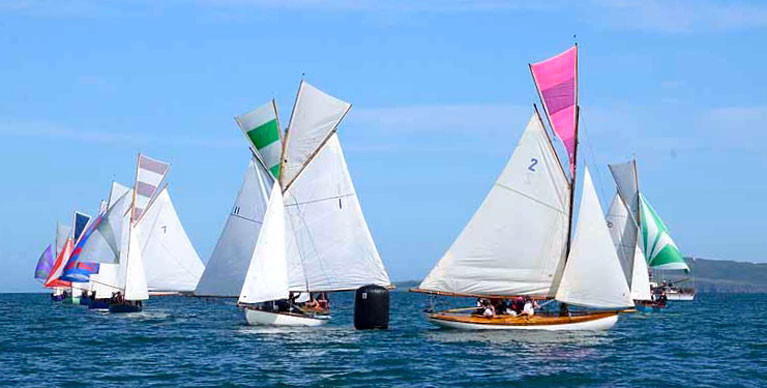Displaying items by tag: Howth Seventeen
In Ireland last week as June drew to a close, the month’s exceptionally high temperatures were already becoming a memory, while the winds were raw along the west coast. Yet in far Southwest Cork and particularly out at Cape Clear, summer was still to be found.
The vintage Howth 17s, on tour to celebrate their class’s 125th Anniversary under the visionary leadership of Class Captain David O’Shea, found a lacuna of reasonable weather in a week of sailing among Carbury’s Hundred Isles in Roaring Water Bay, whose inappropriate title stems from the fact that the Roaring Water River – serene by the time it reaches the sea – flows gently into its sheltered inner reaches.
 No hope? Rosemary in March 2018. Thanks to the skills of boat-builder Larry Archer, she was brought back to life
No hope? Rosemary in March 2018. Thanks to the skills of boat-builder Larry Archer, she was brought back to life
Even had they wished to, they couldn’t have celebrated their 120th back in 2018, as several of the class were still in bits after their storage shed had been flattened by Storm Emma in March. But what with Pandemics and other negative happenings since, it seems to have been intended that this particular week should be used for Cruise-in-Company time, as the 125th Anniversary of their very first race – on May 4th 1898 – had been marked in suitable Quasquicentennial style.
 “As long as you’ve the ballast keel, the boat is not completely lost”. Anita in March 2018. Thanks to the determination of Ian Malcolm of Aura, she was successfully re-created by Skol ar Mor in Brittany
“As long as you’ve the ballast keel, the boat is not completely lost”. Anita in March 2018. Thanks to the determination of Ian Malcolm of Aura, she was successfully re-created by Skol ar Mor in Brittany
And the very best of the weather in this Week of Weeks was out at Cape Clear. But they’d every intention of going there anyway during their celebratory Cruise-in-Company, as Malachy Harkin and his team at Cape Clear Distillery were going to send the little boats back to Baltimore with cargoes of their finest products.
 Very much alive. Anita (David McConnell) revelling in the sailing off the Fastnet. Photo: David O’Shea
Very much alive. Anita (David McConnell) revelling in the sailing off the Fastnet. Photo: David O’Shea
 An enchanted coastline. The Howth Seventeens chose well with the venue for their 125th Anniversary Cruise in Company
An enchanted coastline. The Howth Seventeens chose well with the venue for their 125th Anniversary Cruise in Company
 Faith fulfilled. Ian Malcolm and Aura at the Fastnet Rock. They were last here twenty years ago
Faith fulfilled. Ian Malcolm and Aura at the Fastnet Rock. They were last here twenty years ago
But just to show that they weren’t being exclusively drawn on their way with a nose for special local spirits, they left Baltimore – where the Sailing Club’s Racing Secretary Rob O’Leary had already put in much skilled and highly-appreciated work in getting the boats safely afloat – and slugged upwind to Schull under the watchful eye of Schull’s Mr Sailing, David Harte. His Howth links through sailing and family go back a long way, and he certainly looked the part of the mother-ship in his smart new Boston Whaler, a very different animal from the original Boston Whaler.
 David Harte aboard his new boat
David Harte aboard his new boat
 A warm and welcoming place. Captain Dave O’Shea with Billy O’Sullivan’s in the latter’s very hospitable family pub in Crookhaven
A warm and welcoming place. Captain Dave O’Shea with Billy O’Sullivan’s in the latter’s very hospitable family pub in Crookhaven
From Schull it was upwind again on the Tuesday to Crookhaven, where O’Sullivan’s were well geared up to feed and water sixty-plus thirsty and hungry mariners and their supporting crews’ comforts. Wednesday 28th June had been selected as the primary choice for rounding the Fastnet Rock, as it cut the fleet a bit of slack with Thursday as an option if conditions didn’t suit.
But an admittedly rising westerly was their first fair wind as they began their return east, and it blew the clouds away to provide blue skies and a bit too much for topsails, but several boats went for spinnakers, and those that did reached the Rock in an hour, which for 17ft waterline is way above theoretical hull speed.
There is something supernatural about the Fastnet Rock, and Cape Clear with its much improved North Harbour is such a charmingly out-of-this world place that it might be from another galaxy, a situation which was right in tune with the developing mood of enchantment in the visiting Quasquicentennial class.
 Pumping the adrenalin. Deilginis (Massey, Toomey, Kenny) getting above theoretical hull speed on the run from Crookhaven to the Fastnet Rock
Pumping the adrenalin. Deilginis (Massey, Toomey, Kenny) getting above theoretical hull speed on the run from Crookhaven to the Fastnet Rock
 Wet and wonderful – Erica (Davy Nixon) reaches the rock
Wet and wonderful – Erica (Davy Nixon) reaches the rock
 Time to gybe….Isobel (Brian & Conor Turvey) streaking past the rock, with the sky suggesting they’re getting the best day of the week.
Time to gybe….Isobel (Brian & Conor Turvey) streaking past the rock, with the sky suggesting they’re getting the best day of the week.
 The Cape Clear ferry was at the Fastnet, festooned with photographers as the Howth Seventeens rounded the Rock
The Cape Clear ferry was at the Fastnet, festooned with photographers as the Howth Seventeens rounded the Rock
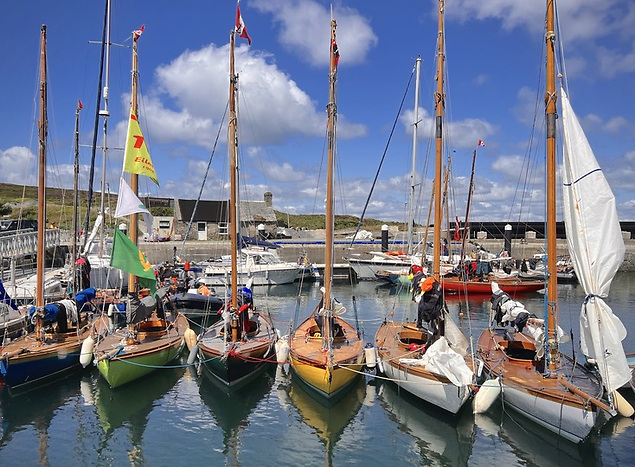 The perfect shelter in North Harbour, Cape Clear after a brisk day’s sailing
The perfect shelter in North Harbour, Cape Clear after a brisk day’s sailing
 “You’ve earned it”. Cape Clear Distillery spreads the good news about its product range through Howth Seventeen sailors
“You’ve earned it”. Cape Clear Distillery spreads the good news about its product range through Howth Seventeen sailors
Sensing that this might happen, the wise old Class Captain had left Thursday’s programme open to each boat’s choice, the only remaining item being a possible race in Baltimore Harbour on Friday morning before lift-out started at 11.00am. But it was blowing strong westerly, and it was raining, and some thought the liftout berth very exposed and possibly unusable.
 The Man Who Worked Miracles. Master boat-handler Rob O’Leary (left) with David O’Shea in Baltimore Sailing Club
The Man Who Worked Miracles. Master boat-handler Rob O’Leary (left) with David O’Shea in Baltimore Sailing Club
But Rob O’Leary demonstrated otherwise. A dozen times he gave a master-class in using a RIB as both towboat to, and fender against, a choppy quayside. And he’d a crane-driver to match. The whole fleet were out, unrigged and ready for the road in four hours.
 Heartfelt thanks. Commodore Grahame Copplestone (left) of Baltimore Sailing Club receives tokens of appreciation from the Seventeen Foot Class and Howth Yacht Club
Heartfelt thanks. Commodore Grahame Copplestone (left) of Baltimore Sailing Club receives tokens of appreciation from the Seventeen Foot Class and Howth Yacht Club
It left everyone in fine form for the concluding supper hosted by Commodore Grahame Copplestone in Baltimore Sailing Club on the Friday night, with Geraldine and her team in the kitchen cooking up a storm, and the good form and bonhomie reaching stratospheric levels. Then by Sunday night, every last little wandering Howth Seventeen was safely back on the home peninsula, with the good news that Howth Yacht Club was so pleased by the favourable publicity they’d generated in several leading outlets that they’d all be craned into Howth Harbour for free.
 West Cork hospitality at its best – the concluding supper and presentation in Baltimore Sailing Club.
West Cork hospitality at its best – the concluding supper and presentation in Baltimore Sailing Club.
 “Dear Leader, we all love you”. Father of the Class Nick Massey shows the Howth 17s’ appreciation for their Captain David “Daisy” O’Shea at the conclusion of an exceptional West Cork Quasquicentennial visit.
“Dear Leader, we all love you”. Father of the Class Nick Massey shows the Howth 17s’ appreciation for their Captain David “Daisy” O’Shea at the conclusion of an exceptional West Cork Quasquicentennial visit.
Even by the long-view standards of the 124-year-old Howth 17 Class, the 48-year owning partnership in the 1907-vintage Rosemary between David Jones and George Curley - with David Potter more recently joining the strength as George turned 90 last year – is a notably enduring relationship. And in their almost half-century of ownership, Rosemary has sailed hundreds of races and won many trophies.
But never before has she scaled the heights of this weekend, when she became the Howth 17 National Champion 2022 after some notably skilled helming and tactics by Davy Jones, in a five-race series in which the Rosemary team fulfilled the golden rules of making less mistakes than everyone else rather than trying to be perfect, and seeing the series as a whole rather then as a set of individual races.
Being the Howth 17s, their National Championship format is unusual in that they have a pier-start race on the Friday evening without setting their distinctive jackyard topsails, and then on Saturday they aim for four committee boat races under full sail.
In theory, Sunday morning is kept in reserve if needed to make a championship. But with a Race Officer of the calibre of David Lovegrove with his special knowledge of Howth’s racing waters, they had someone who could cope with the rising barometer’s determination to kill the gradient westerly breeze, and he got things off to a good start on Friday night with a skillfully-set course within Howth Sound, where summer evening breezes off the land and sometimes off Ireland’s Eye made racing possible despite a sluicing ebb tide.
 Friday evening racing within Howth Sound, without topsails being used. Photo: Patricia Nixon
Friday evening racing within Howth Sound, without topsails being used. Photo: Patricia Nixon
 The finish of Friday’s race close along the pier to avoid the tide was a lineup of noted hotshots, with Deilginis winning from Oona and Isobel Photo: Patricia Nixon
The finish of Friday’s race close along the pier to avoid the tide was a lineup of noted hotshots, with Deilginis winning from Oona and Isobel Photo: Patricia Nixon
And that first race seemed to set the shape of things to come. For although the Howth 17 Nationals as a stand-alone event have been in being since 2001 (they used to call it the Howth 17s Worlds, but modesty has since prevailed), only eight different boat names have been inscribed on the trophy. And the first four in Race 1 were all from that Roll-call of Distinction, with current club-racing pace-setter Deilginis (Massey/Toomey/Kenny) getting first from Peter Courtney’s Oona, with Brian & Conor Turvey’s Isobel third and Ian Malcolm’s Aura fourth, the first non-former-champion being Orla (Marc FitzGibbon & Donal Gallagher) in fifth.
We say “seemed to set the shape of things to come”, for this meant that going into Saturday’s four open courses, the beginnings of private battles were already in place, and this covering of the expected rivals by the established hotshots left the way clear for Ian Byrne and Eddie Ferris with Gladys to win Race 2 from Michael Duffy’s beautifully-maintained purple boat Hera, which was going at truly purple speeds, as her crewing had a significant input from the Sutton Dinghy Club’s hot GP14 Class.
 Michael Duffy’s purple Hera showing a clean pair of heels to Orla and Aura. Photo: Patricia Nixon
Michael Duffy’s purple Hera showing a clean pair of heels to Orla and Aura. Photo: Patricia Nixon
 Ian Malcolm’s 1898-built Aura – a former winner of the title – gets a burst of speed to carry her across ahead of a trio of top boats. Photo: Patricia Nixon
Ian Malcolm’s 1898-built Aura – a former winner of the title – gets a burst of speed to carry her across ahead of a trio of top boats. Photo: Patricia Nixon
Yet third just 30 seconds behind was Rosemary with her regular crew, at the beginning of what was eventually to be a beautifully-series. Admittedly it didn’t look like it at the finish of race 3, as she was back in 8th while the re-born Hera had a win. But in between them were assorted proven performers who were now locked more tightly than ever into personal points challenges.
 There was a light buildup of cloud later on Saturday, but as it kept the breeze alive it was welcome. Photo: Patricia Nixon
There was a light buildup of cloud later on Saturday, but as it kept the breeze alive it was welcome. Photo: Patricia Nixon
This left the way clear for Rosemary to win Race 4, with second going to Oona (Peter Courtney), who almost invariably has the best-set topsail in the whole class, but then his family have been involved since 1907. Meanwhile, aboard Rosemary they’d already calculated that if they could win the last race with their new-found speed, with Hera managing to stay ahead of Oona in second and third while the private battles kept the half dozen favourites at bay, then they’d be home and dry.
A tall order, perhaps, but sometimes some things are just meant to be so. In retrospect, it all looked beautifully choreographed. There was a confidence about the way Rosemary was first to finish, coming through the line even while other boats went across in the opposite direction, still headed for the lee mark.
 Rosemary wins the last race while other boats were still headed down to the lee mark. Photo: Patricia Nixon
Rosemary wins the last race while other boats were still headed down to the lee mark. Photo: Patricia Nixon
 The big picture. To win overall, Rosemary not only had to finish first, but she had to ensure that somehow Hera (right) came in ahead of the yellow Oona, which she managed by just two seconds. Photo: Patricia Nixon
The big picture. To win overall, Rosemary not only had to finish first, but she had to ensure that somehow Hera (right) came in ahead of the yellow Oona, which she managed by just two seconds. Photo: Patricia Nixon
And on top of that, having carried the battling Oona and Hera up to weather of the lay-line, Rosemary’s crew had the satisfaction of seeing them pay off with Hera just getting the edge from the safe leeward position. She was second by just two seconds ahead of the Courtney boat, with the now overall-winning crew (having themselves had a half minute lead on Hera) erupting in a fit of air-punching which would have bemused the Victorian founders of this ancient class.
 What would the Founding Fathers think? Some distinctly non-Victorian air-punching and beer-drinking from Rosemary’s crew when they’ve worked out that they are the Howth Seventeen 2022 National Champions on count-back. Photo: Patricia Nixon
What would the Founding Fathers think? Some distinctly non-Victorian air-punching and beer-drinking from Rosemary’s crew when they’ve worked out that they are the Howth Seventeen 2022 National Champions on count-back. Photo: Patricia Nixon
The air-punching was well merited as they’d already calculated that though they’d finished equal with Hera on 12 points after the discard, they’d dropped an 8th to the Duffy boat’s 10th, making the final lineup:
Howth 17 National Championship 2022:
1st Rosemary (David Jones, George Curley & David Potter) 12 pts; 2nd Hera (Michael Duffy) 12 pts; 3rd Oona (P. Courtney, 13pts; 4th Isobel (Brian & Conor Turvey) 15pts; 5th Deilginis (Massey/Toomey/Kenny) 16pts; 6th Orla (M FitzGibbon & D Gallagher) 21pts. 18 boats raced.
 Done it! Rosemary’s crew were Jack Haydon, David Potter and Davy Jones. Photo: Patricia Nixon
Done it! Rosemary’s crew were Jack Haydon, David Potter and Davy Jones. Photo: Patricia Nixon
One of the Howth 17s’ secrets of survival is that they maintain a diligently-implemented handicap system, and under this the winner was Eileen (R Macken), with the stellar Rosemary taking second, while Silver Moon (Susan Morgan) was third.
Another secret of the class’s survival is their sheer stubbornness. Back in March 2018 after Storm Emma had struck seven of the class in the destruction of their storage shed on Howth’s East Pier, the more impatient and pessimistic observers reckoned that Rosemary was a write-off, for while some boats had suffered only superficial damage, she had been reduced to a flat-pack.
 Beyond hope? Rosemary reduced to a flat-pack by Storm Emma in March 2018
Beyond hope? Rosemary reduced to a flat-pack by Storm Emma in March 2018
But when you’ve been in partnership with a boat for as long as this, different values prevail, and in Larry Archer the Rosemary team had a boat-builder of sufficient eccentricity to agree that she could be squeezed out into her proper shape again, and made fully seaworthy with it. Four years after that scene of disaster, Rosemary has shown how right they all were. And now she is Queen of the Class as they look forward to their 125th Anniversary Celebrations in 2023.
 The road to recovery. Rosemary gradually being encouraged back into her proper shape with a new deck and much other work by Larry Archer through the winter of 2018-19. Photo: David Jones
The road to recovery. Rosemary gradually being encouraged back into her proper shape with a new deck and much other work by Larry Archer through the winter of 2018-19. Photo: David Jones
The vintage Howth 17 Class have registered Annual General Meetings every year since 1898. But although 124 summers have passed since their first season of 1898 - which thereby counts as Year One and not Year Zero - they can look back on only 121 seasons, as the Great War of 1914-18 got in the way of sailing in the latter half of 1915, and throughout the summers of 1916, '17, and '18.
Nevertheless, 121 seasons of sailing boats to a design that first raced on Wednesday, May 4th 1898 is probably world-beating, particularly as the five original boats are still part of a class that now numbers twenty. But it's not a thing the people involved get into a pother about, as they're too busy getting on with racing.
Classic yacht purists are sometimes a bit snooty about the significance the Seventeen folk (a motley crew if ever there was one) attach to their racing. But in a normal year, they get between fifty and sixty races fitted in, and it's the sport that is the all-powerful glue holding the class together.
With an attitude like this prevailing, the class's most ancient trophies aren't seen as the Holy Grail - they're much more important than that. And few prizes match the Studdart Cup, presented at the beginning of it all by Johnny Studdart, who represented the more convivial side of the otherwise rather austere 1895-founded Howth Sailing Club, as Johnny sailed the hospitable and perfectly-named little cruising yawl Sunshine, which was already old when the Seventeens came into existence.
 The notably convivial Johnny Studdart in the 1890s at the helm of his little cruising yawl Sunshine, which was already a very old boat when the Howth 17s came into existence in 1898. Photo courtesy HYC
The notably convivial Johnny Studdart in the 1890s at the helm of his little cruising yawl Sunshine, which was already a very old boat when the Howth 17s came into existence in 1898. Photo courtesy HYC
But her owner was young in spirit, and he presented the new class with the Studdart Cup with the idea of encouraging season-long involvement, as the boats eligible for it are the winners of the three main evening and Saturday series held each season. If a boat happens to have won two of these series, she automatically wins the Studdart. But the continuing health of the class is indicated by the fact that as often as not there's a three-way sail-off for Old Johnny's cup.
Or more accurately, Old Johnny's Idea. The original Studdart Cup was liberated at dead of night from the Howth home of a several-times-winner very many years ago, doubtless by some idealistic peninsular Robin Hood. But the ideal it represented was so central to the class's history that it was soon replaced, so now they compete for this Unholy Grail with every bit as much enthusiasm.
However, with 2021's peculiar pandemic-distorted season, the final official race of the Howth 17's programme was completed with the last race of the Beshoff Motors Autumn League on October 16th, yet the 2021 Studdart Cup contest between Rita (No 1, John Curley & Marcus Lynch), Aura (No 7, Ian Malcolm) and Orla (No 21, Mark FitzGibbon & Donal Gallagher) was still un-sailed.
 Three-way duel. Despite a 119-year age difference in the three boats involved, the 2021 Studdart Cup contest between (left to right) Orla, Rita and Aura lived up to the trophy's reputation for close racing. Photo: Brian Turvey
Three-way duel. Despite a 119-year age difference in the three boats involved, the 2021 Studdart Cup contest between (left to right) Orla, Rita and Aura lived up to the trophy's reputation for close racing. Photo: Brian Turvey
This had added significance as there's a 119-year age-gap between the first two "originals" and Orla, which was built in 2017 under Ian Malcolm's guidance at Mike Newmeyer's Skol ar Mor in southern Brittany. It was a lineup symbolic of the spirit of the class, so in the end the scope provided by the breezy Bank Holiday Weekend was utilised to the full, with all crews on weekend alert, and the brisk but very sailable sunny sou'wester of Monday morning finally provided a fast contest from a pier start.
Donal Gallagher at the helm of Orla was in the lead at the South Rowan Buoy and was still there – though only just – as they rounded the Spit for the seriously uphill stuff. Though topsails were definitely a no-go, spinnakers were deployed whenever possible. But although the two partners in Orla only acquired her as recently as the Spring of this year when they were so chuffed they had a piper lead the boat to the crane on launching day, they defied their newbie standing, and held the lead with Rita helmed by Marcus Lynch in second closely ahead of Aura.
It was a high and bright note on which to end the season. But now the very old, the old, and the not-so-old boats of this unique class are rapidly going from the harbour, headed for their many and various winter quarters ashore and the TLC which keeps this remarkable show on the road.
 A great way to end their first season: Donal Gallagher and Mark FitzGibbon bring Orla to the finish line to win the 2021 Studdart Cup against the distinctive background of Ireland's Eye. Photo: Brian Turvey
A great way to end their first season: Donal Gallagher and Mark FitzGibbon bring Orla to the finish line to win the 2021 Studdart Cup against the distinctive background of Ireland's Eye. Photo: Brian Turvey
The Howth 17 Nationals 2020 saw five good races sailed – a pier starter on Friday evening, and four committee boat open water races on Saturday – with the sunny nor’east wind holding up enough for the four open water contests to provide some cracking racing, although it never developed into the hearty sea breeze which might have been expected.
But even with the gentler conditions, there was still just enough power for proper closely-contested sport, and the best competitive showing saw everyone in the fleet of eleven across the finish line within three minutes, with some private contests separated by less than five seconds.
 At times the wind looked like it was on its last gasp instead of developing into a decent sea breeze, but always it returned with just enough strength for close racing. Age comparison in close quarters with (left to right) Aura (1898, Ian Malcolm), Pauline (1900, Shane O’Doherty & partners), Gladys (1907, Eddie Ferris & Ian Byrne), Orla (2018, sailed by Gerry Comerford) and Deliginis (1907, Massey, Toomey & Kenny). Photo: Conor Lindsay
At times the wind looked like it was on its last gasp instead of developing into a decent sea breeze, but always it returned with just enough strength for close racing. Age comparison in close quarters with (left to right) Aura (1898, Ian Malcolm), Pauline (1900, Shane O’Doherty & partners), Gladys (1907, Eddie Ferris & Ian Byrne), Orla (2018, sailed by Gerry Comerford) and Deliginis (1907, Massey, Toomey & Kenny). Photo: Conor Lindsay
 Hazy days of summer – Howth may have developed since 1898, but the Seventeens remain resolutely unchanged. Photo shows Pauline, Rosemary and Sheila, with topsail of Deiliginis beyond. Photo: Trish Nixon
Hazy days of summer – Howth may have developed since 1898, but the Seventeens remain resolutely unchanged. Photo shows Pauline, Rosemary and Sheila, with topsail of Deiliginis beyond. Photo: Trish Nixon
Overall winner, with the final race the decider, was Shane O’Doherty sailing the 1900-built Pauline. He’s known to some as The Mountainy Man, as he runs an outfit called Shane’s Howth Hikes, which in normal times (remember them?) takes visitors to the peninsula on quite energetic walking tours (there’s an electric bike option as well) of the Hill of Howth and its more extraordinary features, most of which the locals take for granted or don’t even know about.
Yet even in the busiest visitor times in non-lockdown years, Shane always keep Saturdays free for sailing while a colleague looks after the tours, for he regards racing with the Howth 17s as an essential part of the Howth experience, and it re-invigorates his love of the place.
 HYC Commodore Ian Byrne and Eddie Ferris with Gladys (14) look to have done well with the pin start, but others had taken over the lead by the finish. Photo: Trish Nixon
HYC Commodore Ian Byrne and Eddie Ferris with Gladys (14) look to have done well with the pin start, but others had taken over the lead by the finish. Photo: Trish Nixon
For now, that love is total and unquestioning, as conditions suited the Clancy of Kingstown-built Pauline to perfection for the Championship, and she finished two points clear – after that final race decider - of the defending champion Deilginis (Massey, Toomey, Kenny) of 1907 vintage, with Dave Mulligan’s 21st Century “new” boat Sheila third, and another 1907 boat from Kelly of Portrush, the George Curley, Davy Jones and David Potter-owned Rosemary, notching fourth with a scorecard which included the win in Race 4 and a third in Race 5.
 Rosemary (George Curley, Davy Jones & David Potter) wins Race 4 from Sheila (Dave Mulligan). Rosemary looked to be a write-off after Storm Emma’s shoreside damage in March 2018, but ace Fingal boatbuilder Larry Archer worked miracles to bring her back to life. Photo: Trish Nixon
Rosemary (George Curley, Davy Jones & David Potter) wins Race 4 from Sheila (Dave Mulligan). Rosemary looked to be a write-off after Storm Emma’s shoreside damage in March 2018, but ace Fingal boatbuilder Larry Archer worked miracles to bring her back to life. Photo: Trish Nixon
 Lambay beyond – as unspoilt as the most remote Hebridean island – while light-wind flyer Rita (No 1, John Curley & Marcus Lynch) tests an ultra-flexible topsail yard. Rita won the first race, but an uneven performance thereafter kept her out of the frame, and she was fifth overall on scratch. Photo: Conor Lindsay
Lambay beyond – as unspoilt as the most remote Hebridean island – while light-wind flyer Rita (No 1, John Curley & Marcus Lynch) tests an ultra-flexible topsail yard. Rita won the first race, but an uneven performance thereafter kept her out of the frame, and she was fifth overall on scratch. Photo: Conor Lindsay
While the Howth Seventeens may be the world’s oldest one-design keelboat class, particularly when it’s further qualified by still having the original rig and with the added restriction of all the boats being in the one harbour, nevertheless their personnel lineup is encouragingly supra-national and broad-minded in its outlook.
Thus Shane O’Doherty’s partners in the boat are Michael Kenny -who couldn’t be there as he’s based in Warsaw - and Sutton Dinghy Club Commodore Ian McCormick, who was away in West Cork on a Sportsboat campaign. But being The Mountainy Man, the skipper recruited on his hillside with some heather (Wayne Heather to be precise) and some holly (his daughter Holly O’Doherty). With Brendan O’Brien on the strength to add a surname of unimpeachable Irish sailing distinction, it was all systems go for success for Pauline, with the skipper revealing further insight at the outdoor prize-giving, as his T-shirt told us “Harbours rot ships and men”.
 The Mountainy Man and his heather and holly……winning skipper Shane O’Doherty (left) with crew Wayne Heather, Holly O’Doherty and Brendan O’Brien. Photo Howth 17 class
The Mountainy Man and his heather and holly……winning skipper Shane O’Doherty (left) with crew Wayne Heather, Holly O’Doherty and Brendan O’Brien. Photo Howth 17 class
One of the secrets of the Howth Seventeens’ longevity is their determined application of a parallel handicap system to ensure that other boats emerge out of the cannon fodder division to get their place in the sun. It was very well demonstrated this time round as the winner was another Clancy 1900 boat, Anita owned by David O’Connell (Phibsborough) in partnership with helm Muige Karasahin (she’s from Istanbul), with crewing by Elizabeth Jakobson (from Latvia) and Susan Morgan (Sutton).
Anita – re-built by Paul Robert and his team at Les Ateliers de l’Enfer in Douarnenez in Brittany in 2019 after being destroyed by Storm Emma in Howth in March 2018 – was certainly finding her feet as the series progressed, and logged a scratch second in the last race. But even with that, she was sixth overall on scratch in the final tally, yet that became a clear win with the handicaps in an interesting case of sailing for Byzantium within sight of a house where the family of W B Yeats lived for two years in the early 1880s.
 Sailing for Byzantium…..with Muige Karasahin of Istanbul on the helm, Anita (D. O’Connell & M Karasahin) was overall winner of the handicap division. Virtually a total loss after Storm Emma in March 2018, Anita was re-built by Paul Robert’s Les Atelier de l’Enfer (The Workshops of Hell) in Douarnenez in Brittany Photo: Conor Lindsay
Sailing for Byzantium…..with Muige Karasahin of Istanbul on the helm, Anita (D. O’Connell & M Karasahin) was overall winner of the handicap division. Virtually a total loss after Storm Emma in March 2018, Anita was re-built by Paul Robert’s Les Atelier de l’Enfer (The Workshops of Hell) in Douarnenez in Brittany Photo: Conor Lindsay
The clear division between scratch and handicap continued down the listing, with Tom Houlihan’s Zaida taking second, though there was then an element of overlap as Rosemary (fourth on scratch) was handicap third while scratch winner Pauline was fourth, the double results give everyone at least one good race.
As for sailing enjoyment in a summer when travel is restricted, the weather was such that you could find whatever you wanted off Howth, as the view to the east was of Irelands Eye which looks like a piece of Connemara transferred to the Irish Sea, to the north Lambay would not look amiss in the Hebrides, to the west the dunes of Portmarnock are reminiscent of the Vendee, and to the south with a fore-shortened lens against the strong sunshine, you could be looking at the French Riviera as the narrowed eyes take in the flank of the Hill of Howth and the Wicklow Mountains beyond.
Howth 17s Nationals 2020 (Scratch) Results
1st Pauline (S. O’Doherty, I. McCormick & M. Kenny): (4),3,1,3,1: 8pts; 2nd Deilginis (Massey family, M.Toomey, K, Kenny) 3,1,2,4, (5): 10 pts; 3rd Sheila (D.Mulligan) 2,(7),4,2,6: 14pts; 4th Rosemary (G, Curley, D. Jones, D.Potter) 16pts.
Howth 17 Handicap
1st Anita (D. O’Connell & M. Karasahin), (2), 1,1,1,1: 4 pts; 2nd Zaida (T. Houlihan) 1,2,2,2, (3) 7 pts; 2rd Rosemary (Curley, Jones, Potter) (3), 3,3,3,2: 11 pts; 4th Pauline (O’Doherty, McCormick, Kenny) (7), 6,4,5,4.
 Who needs to go away on holiday when the view southward, from the race area past the Hill of Howth and on towards the Sugarloaf in the Wicklow Mountains, could pass as the French Riviera? Photo: Conor Lindsay
Who needs to go away on holiday when the view southward, from the race area past the Hill of Howth and on towards the Sugarloaf in the Wicklow Mountains, could pass as the French Riviera? Photo: Conor Lindsay
Deilginis Retains Howth 17 Title for Fourth Time
The classic Howth Seventeens have not survived and thrived since 1898 through having a narrow perception of themselves writes W M Nixon. When they decided some years ago to add an annual two-day championship to their already busy 60-race season of regular midweek evening and Saturday afternoon contests plus regattas and the Howth Autumn League, they announced it as the Howth Seventeen Worlds.
Told by the Powers That Be that they couldn’t call it that, the following year it became the Howth Seventeens Inter-Galactic Title. Eventually, it became the Howth Seventeen ‘Nationals’, and that’s what they challenged for yesterday (having lost Friday evening’s first race because of a gale), with Race Officer Scorie Walls managing to fit in three races between wind bombs and thundery downpours which were deluging much of the rest of Ireland.
Admittedly conditions were marginal, with a strong and gusty westerly as fifteen boats came to the line for the first race. Certainly, it wasn’t a top’l day, but spinnakers were flown, and though there were some retirals, damage was relatively minor with a broken spinnaker pole or two, and some trouble with jib halyards.
Thus the boats re-built after the shoreside carnage of Storm Emma, (aka The Beast from the East) back in March 2018 showed that they were able for it, but it has to be admitted that it was a race for physically strong crews. When the Seventeens first appeared, they were frequently raced with just two on board. Gradually this became three, but these days these able little 22ft 6ins boats seem to do best with four on the strength, and strength was at a premium yesterday.
"Some said it was really too windy and volatile to be taking any boats out"
The Masseys and Mike Twomey on the 1907-built Deiliginis had a field day with a scoreline of 1,5,1. Their very able-bodied crew were brothers Luke and Jamie Massey, their cousin Ian Massey, and Mikey Twomey, and their accomplished sailing made it four in a row for a title Deilginis has won at least six times in all.
It was a very special day for Roddy Cooper, as it was his 70th birthday. He has owned the 1898-built Leila since 1998, the two previous owners being Seventeen class legend Norman Wilkinson, and before him Billy McBride, who was a special talent in the renowned Harry Clarke stained-glass workshops.
Birthday Boy Roddy was crewed by his sons Drewry and Giles and longtime shipmate Ian Jackson, and they finished the series second overall on 11 points to Deilginis’s final score of 2, while third was Peter Courtney in Oonagh on 13 points.
Peter Courtney is third generation Howth Seventeen - his grandfather first owned one of the boats in 1907 - and for the ‘Nationals’ his crew were Daisy O’Shea, Dinger Massey and David O’Connell.
Some said it was really too windy and volatile to be taking any boats out, let alone boats where four of the fleet were 121 years old. But you won’t hear that said by the twelve guys who were on the three leading boats…….
Howth's Maritime & Sailing History is Brought Centre Stage
#hyc – A new billboard on Howth Yacht Club's prominent gable wall has re-kindled local and general interest in the Fingal port's place in Irish and international sailing and maritime history. And it has led to an upsurge of warm local pride around Howth Harbour. After a summer visiting other ports, W M Nixon returns home and tells how it all came about, and of the re-vitalised seaborn sport which has resulted from this imaginative initiative.
The world's most historically interesting and best-preserved one design keelboat class is hidden in plain sight just 14 kilometres from the heart of Dublin. And at the entrance to the harbour where these very significant boats have their secret summer existence, there stands the most perfect little classic lighthouse you ever saw. It too is hidden in full view.
Or at least, it all seems virtually invisible for many of the folk who live in Howth, who have simply become so accustomed to the presence of the 1817-built lighthouse and the 1898-founded Howth Seventeen Class that they scarcely appear to notice them any more. They seem to take them for granted, as is the case many of the other special features of what is a remarkably successful fishing and sailing port.
Well, maybe they do take a little bit of notice. Certainly if some environment-altering project gets under way which doesn't meet with quiet general approval, you'd be surprised by the level of opposition which can be aroused, and with effect too. But it's part of Howth's reserved way of doing and seeing things not to make a song and dance about local features of importance and attraction when they are as they should be. For it is a fact that, well within living memory, Howth most certainly didn't exude prosperity. So the ingrained pessimism of a fishing port means that when things are going well and the place is functioning as it should, you just stay quiet and don't make a song and dance about the good times rolling.
Nevertheless, now and again when someone with experience of the outside world, and the standing to have opinions which matter, says that Howth is very special and it's time somebody said so, we're quietly rather pleased. And when it's done in in a way which has the style and effect of the new Mercedes-Benz billboard on the prominent gable wall of Howth Yacht Club, we're very pleased indeed.
This billboard encapsulates much that it is significant in the history of Howth Harbour, and it gets the spirit of the place. It shows four boats of the Howth Seventeen class (the "17" refers to their waterline length) gliding in close formation under their full jackyard tops'l rig into the harbour past the gem of a lighthouse in a photo which is so pin sharp that you can easily read the date plate of 1817 on the lighthouse.

The Howth Seventeens which made it to stardom are (left to right) Hera (Michael Duffy0, Oona (Peter Courtney), Isobel (Brian & Conor Turvey) and Aura (Ian Malcolm) Photo of David Branigan photo by W M Nixon
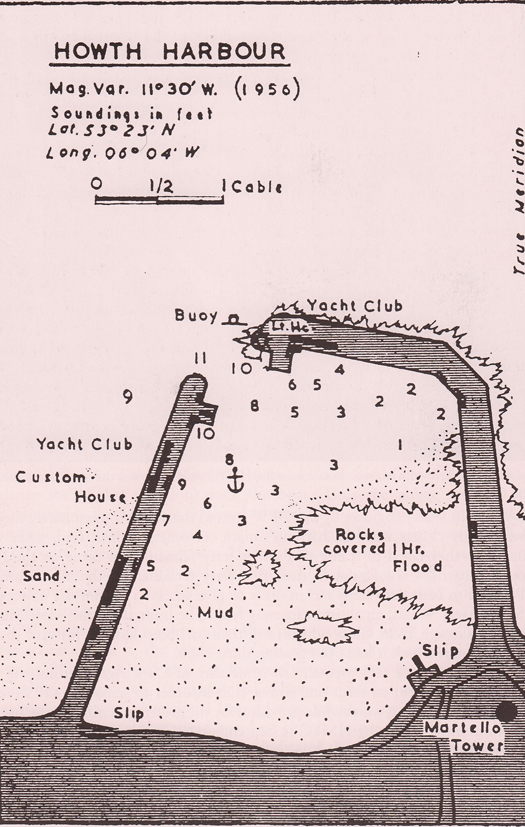
Howth was a distinctly disadvantaged port until relatively recently. Used as the main Dublin ferry port only between 1817 and 1826 (when Dun Laoghaire took over), it only became a "fishing station" around the 1840s-1850s. Then when the herring were fished out by the 1890s, some recreational boating space became available. But even by the late 1950s, as seen here, it was still a very limited harbour.
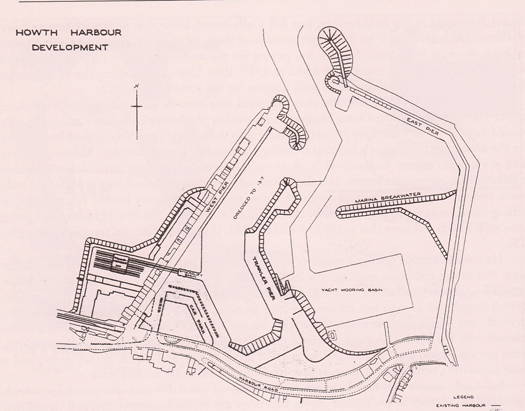
This outline plans for a major Howth redevelopment became available in the late 1970s. In those days, the very idea of a marina was anathema to some interests. So although a new breakwater is indicated as the "Marina Breakwater", the actual space in which Howth YC were to be obliged to install a marina at their own expense was only referred to as a "Yacht Mooring Basin".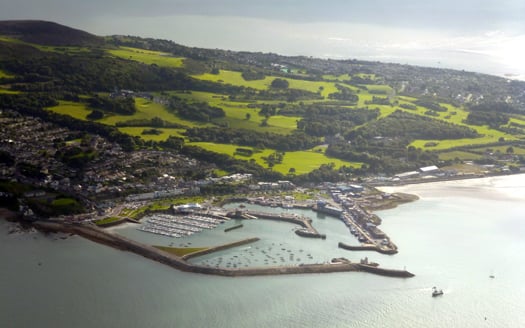
Howth Harbour as it is today, looking southwest across the peninsula with the waters of Dublin Bay at Sutton at top of photo. With clearcut boundaries between the different harbour uses, it has become a harmonious place. The presence of an active fishing port has led to a proliferation of good seafood restaurants. And the preservation of swinging moorings in the northeast corner of the harbour (foreground) has enabled the historic Howth 17s to survive and prosper. Photo: W M Nixon
The Howth Seventeens are part of Irish and international sailing lore. They still sail to the original design by Herbert Boyd of Howth House as signed off in October 1897, and they still race as keenly as they first did on May 4th 1898. More keenly, in fact - they currently have something like sixty races a year, and new boats and new owners and crews have lately been joining the fleet.
As to how they have acquired this overnight fame after 116 years, it's down to Stephen O'Flaherty of Mercedes-Benz. He brought together the needs of Howth YC for a sponsor for their Autumn League in concert with the fact that his quality marque sought a happy match with something which allied classic and timeless style, and could withstand the prolonged exposure of being on a highly visible billboard for the three years of the contract.
Working in close consultation with former and present HYC Commodores Derek Bothwell and Brian Turvey, the idea developed of a big screen photo which would encapsulate key aspects of Howth's unique maritime features in a clear and eloquent combination. Stephen O'Flaherty is owner of the achingly handsome Spirit 54 Soufriere, so he has an eye for a good-looking boat. And as a relative newcomer to being a Howth peninsula resident, he still sees it all afresh.
He pointed out that the little lighthouse at the end of the East Pier is still beautifully maintained, though it is now redundant as the working lighthouse is further north on the breakwater extension added in the early 1980s. Indeed, it is still even inhabited, and for many folk from elsewhere, that plucky little historic lighthouse symbolizes the spirit of Howth. It looks just as a lighthouse should, and it provides a perfect background for a sailing scene featuring the Howth 17s.
So all that was needed was a suitable day to get ace marine photographer David Branigan of Dun Laoghaire (who showed at last year's J/24 Worlds in Howth that he has a talent for drawing the locals' attention to the more picturesque aspects of their port and peninsula), line up half a dozen well-presented Howth Seventeens complete unto jackyard tops'ls, and get them in a harmonious arrangement with the lighthouse in the background and the flanks of the steep island of Ireland's Eye beyond, and lo and behold you have your magic picture, just like that.
Anyone who has ever tried to take a photo of just one boat sailing will realize what an extraordinary challenge this was, as even with one boat you're relying on the presence of a breeze, you're hoping for sunshine, and you're praying that when the best moment arrives, nobody will be standing up on deck or in the cockpit, or looking at the camera, thereby ruining the balance of the photo. And that's just with one boat.
Worse still, it all had to be brought together at very short notice. But the first day suggested for a photo shoot – Thursday August 28th and already under pressure with just two weeks and a couple of days to go to the start of the Autumn League – was a complete no-go with adverse conditions. Time was running out. It had to be Monday September 1st.
They had neither decent breeze nor sunshine on the day, and getting the Howth Seventeens to sail in concert is about as easy as herding cats. As for the wind, it was only fitful from the east, while to the inexperienced eye, the light seemed very flat, and no sunshine.
On top of that, team head Joanna Kavanagh of MSL had only been available on the Thursday – by Monday she was on another photo shoot in Portugal. But far from letting this get them down, the location team rose to the challenge. And the Howth Seventeen sailors gave of their best for a whole day. Show me a Howth Seventeen sailor, and I'll show you a ham......
In the cruel ways of Tinseltown, of the six Howth Seventeens which gave of their very best for that long and often frustrating day's shooting, two ended up on the cutting-room floor - Roddy Cooper's Leila and the Nick Massey syndicate's Deilginis. The final masterful Branigan photo shows Ian Malcolm's Aura (no 7) ahead of Peter Courtney's Oona (no 17), Conor and Brian Turvey's Isobel (no 19) and Michael Duffy's Hera (no 9).
As a sailing photo, it mightn't garner enough excitement to make it into a yachting magazine. But as a billboard designed to tell a story in a specific location, it tells ten thousand words, and tells them very well too. And as clearly as possible – Jason Hurley of Jason Hurley Designs, who was involved in the shoot, also cleaned up the raw photo afterwards to enhance it and take out stains from sails, scrapes from topsides, and weed from waterlines. When it went up just three days before the Autumn League was due to start on Saturday September 13th, it was to be greeted with a shared wave of enthusiasm of a kind which is rare enough in a quirky little community like Howth.
Needless to say, there were soon the usual quips to be heard. The Howth Seventeens survive through turning the laws of physics on their heads. Thus while energy creates friction for other folk, among Seventeen-footer persons it's friction which creates energy. There's nothing like a barbed remark or two to sharpen enthusiasm for the next race. So for those who have said that it takes a posed billboard photo to ensure that Ian Malcolm with Aura will be at the head of the fleet, let me say that in addition to winning races now and again, nobody else in the class has done as much to tell the world that the Howth Seventeens are alive and well and sailing more keenly than ever, and here's a selection of just some of the things that Aura has done in the last sixteen years:
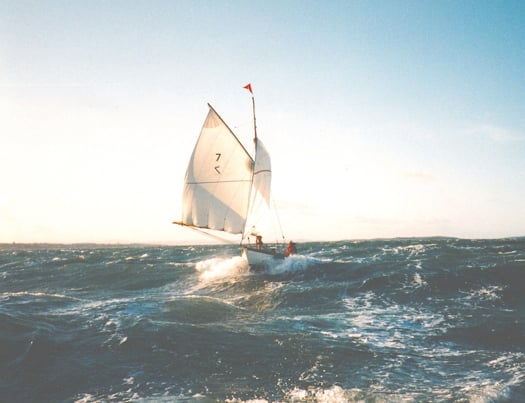
Aura goes offshore. In 1998, the Howth 17s celebrated the Centenary of their inaugural voyage from builder John Hilditch of Carrickfergus 95 miles non-stop back to Howth. Aura is seen here starting to get offshore off the County Down coast as a bright but very cold evening draws in on April 15th 1998. Photo: Damian Cronin
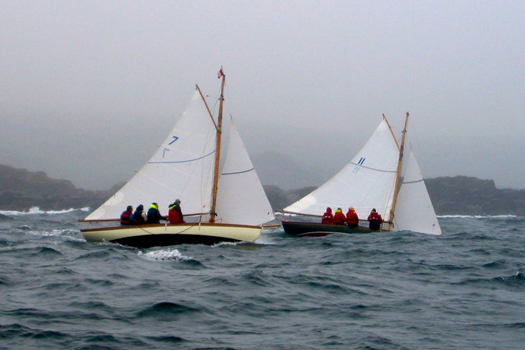 The Howth 17s make the scene at the Glandore Classics 2003 with a foggy race from Castlehaven to Glandore. Here, Aura is chasing Deilginis close inshore. The winner was the first boat to have a crewman downing a pint in Casey's bar in Glandore. Photo: W M Nixon
The Howth 17s make the scene at the Glandore Classics 2003 with a foggy race from Castlehaven to Glandore. Here, Aura is chasing Deilginis close inshore. The winner was the first boat to have a crewman downing a pint in Casey's bar in Glandore. Photo: W M Nixon

In 2008, Aura was the only Howth 17 to take part in the Waterways Ireland Classic Boat Regatta at Dromineer on Lough Derg. She is seen here sharing the lake with an International 12, Water Wags, Shannon One Designs and a Folkboat together with the 1873-built committee boat Phoenix (John & Sandra Lefroy). It was the first time a jackyard tops'l had been seen on Lough Derg since before the Great War of 1914-18, as the post-war fleet there were either gunter or Bermuda rigged. Photo: Gerardine Wisdom

Aura and Deilginis off the Royal Yacht Squadron Castle at Cowes in July 2013 during the Classic One Designs Regatta. It is thought to be the first time the Howth 17s were in the Solent. Photo: Mel Massey
As to the Howth Autumn league, it started 35 years ago in a low key sort of way, when the boats of the newly-formed Squib Class realized they'd been at full first season fleet numbers for only a few weeks, yet if they followed the local wooden-boat traditions, they'd soon be laying up. But the Squib is a minimal maintenance little 19ft keelboat, most of the boats were new in any case, and the Lasers had been having their annual winter series in Howth since October 1974. So the Squibs decided to tag themselves on to the Laser race officer team, and continue their sailing until early December, and thus was the Howth Autumn League born, though it didn't become a fully-fledged all-keelboat-classes business until the marina opened in 1982.
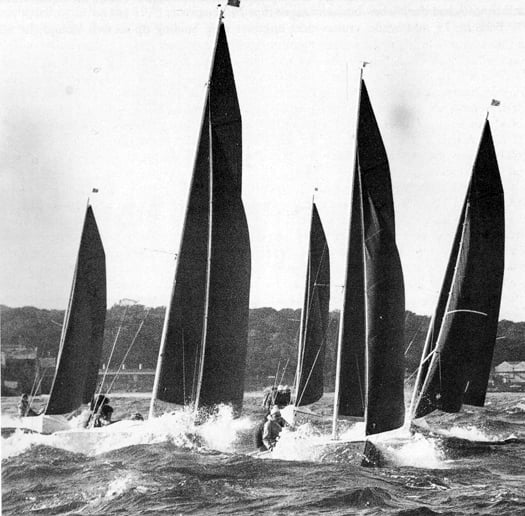 When it all started. The newly-established Squib Class inaugurated the Howth Autumn League in 1979, and this was the first race of that series. Photo: Jamie Blandford
When it all started. The newly-established Squib Class inaugurated the Howth Autumn League in 1979, and this was the first race of that series. Photo: Jamie Blandford
Underlying all this, the Howth Winter Lasers will be celebrating their 40th Anniversary. And it also means that HYC have had a continuous sailing programme since their Opening Day in April 1974. But last weekend the first race of the Mercedes-Benz Autumn League 2014 was enough to be going on with, sailed to mark the new sponsorship and the 35th anniversary of the inaugural Autumn League. And as I was one of those mad keen little Squib skippers 35 years ago, it was an ideal opportunity to take up an invitation to race on Soufriere and mark it all with a bit of style.
She has been having a good year on the race courses. Stephen O'Flaherty has teamed up with David Cagney to bring that wayward sailing genius into his regular crew, and while you wouldn't dream of calling them the Odd Couple, the phrase springs irresistibly to mind. They have raised Soufriere's racing to a new level, with an excellent win in the long inshore race at the Panerai Classics at Cowes in July, and then last month they found a new level of joint success with an extremely good debut in Two-Handed racing in the Aqua Double-Hander at Howth, leading a fleet of 34 boats on the water and on corrected time for much of the race round Lambay and the Kish and back to Howth Harbour, only slipping to a close second overall through being becalmed for a couple of minutes just yards short of the finish line.
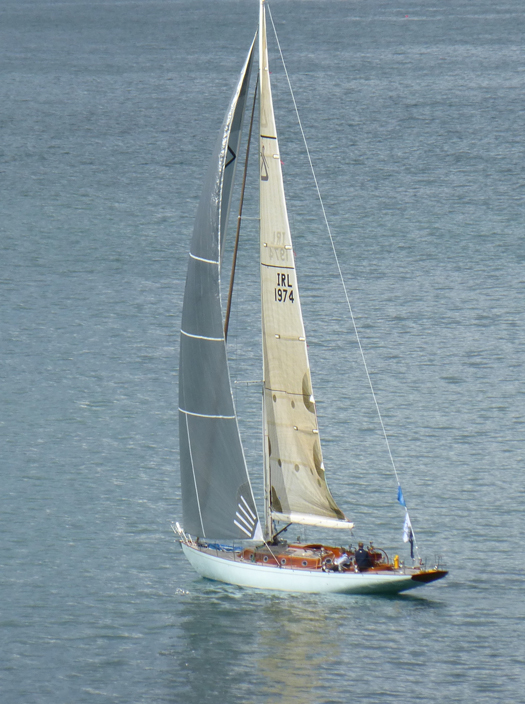 Soufriere approaching the finish of the Aqua Double-Hander at Howth in August, when she would have won overall on both handicaps had she not been becalmed for four minutes within yards of the line. That race-winning headsail may look gossamer light, but on a 54-footer it weighs around 40 kilos, and it's quite a haul for a two man crew to get it aloft. Photo: W M Nixon
Soufriere approaching the finish of the Aqua Double-Hander at Howth in August, when she would have won overall on both handicaps had she not been becalmed for four minutes within yards of the line. That race-winning headsail may look gossamer light, but on a 54-footer it weighs around 40 kilos, and it's quite a haul for a two man crew to get it aloft. Photo: W M Nixon

A penny for your thoughts....David Cagney and Stephen O'Flaherty pondering the options for Soufriere when their just isn't enough wind to get the big lady moving properly. Photo: W M Nixon
Many folk would think it absurd to race a "new classic" like Soufriere against the likes of our opposition last Saturday, as it included Nobby Reilly and Alan Chambers' Mills 36 Crazy Horse, and the Kelly team's J/109 Storm which is always there or thereabouts in ICRA Racing, and has been ICRA Boat of the Year in her time. But Soufriere has a modern underwater profile of vertical bulb keel and spade rudder, and despite her very attractive wood construction in edge-glued strip planking, her all-up weight is only about nine tons.
Nevertheless, she does have to cart about these elegant long ends, which are only an asset for extra speed when the wind is above a certain strength. To add to the challenge, the ideal minimum wind varies, dependent on which point of sailing you're on. Beating, she seems to come to life in as little as 6 knots real wind speed. Reaching, you need about 8 knots. But downwind, she's sticky until it's getting near 10 knots, and preferably more.
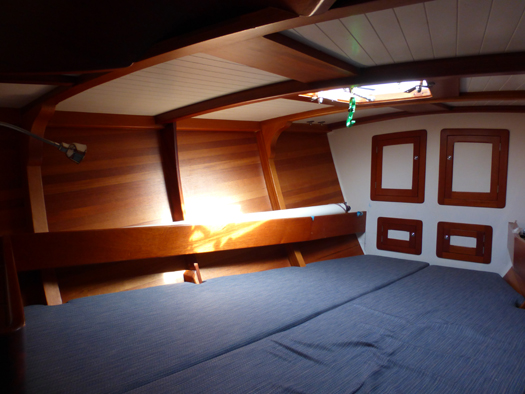
The forward cabin shows the Spirit style. With the wooden hull unlined, the noise of the water going past is pleasantly distinctive. Photo: W M Nixon
As to the impression on going on board, you have to think of Soufriere as they do with the Howth Seventeens, in terms of her waterline length. She certainly doesn't have anything like the accommodation of a standard modern 54 footer, and even her waterline length of 12m (39ft 8ins) suggests more room than there is, as her beam is only 3.3m (10ft 10ins). But within that, the accommodation is welcoming and elegant, and the boat gives out very pleasant vibes, as she is immaculately maintained by Tim Foley of Dun Laoghaire.
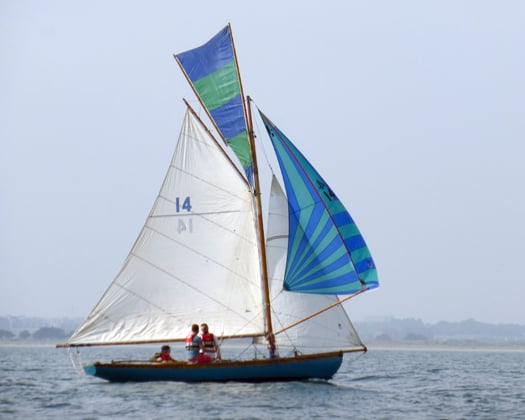
Back in harness. Aidan MacManus of the King Sitric Restaurant has re-joined the Howth 17s by buying the Howth 17 Gladys in partnership with Kieran jameson and others. He first bought Gladys in 1974, and is the first helmsman to have won a race in the Seventeens with 16 other boats astern. Photo: W M Nixon
Going out for the that first race of the re-vitalised Autumn League last Saturday, we motored quietly along past noted restaurateur Aidan MacManus in his Howth 17 Gladys, which he has re-bought in partnership with Kieran Jameson and others. Aidan first bought Gladys in 1974, and he is written permanently into the class's history as in 1988 he was the first skipper ever to win a Howth 17 race with 16 other boats behind, for in a class of such great age, it's seldom that any season will see all the boats afloat.
The wind was light easterly on a day which belied it was mid-September, shirt sleeves stuff and careful reading of summery conditions which were too light for Soufriere. But the team gave it their best shot, and when there was occasionally that essential little bite to the breeze, suddenly we were at the races.
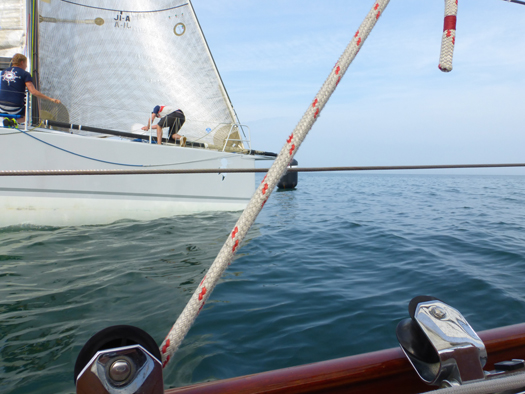
Reaching the weather mark neck-and-neck with Crazy Horse but miraculous to tell.......... Photo: W M Nixon
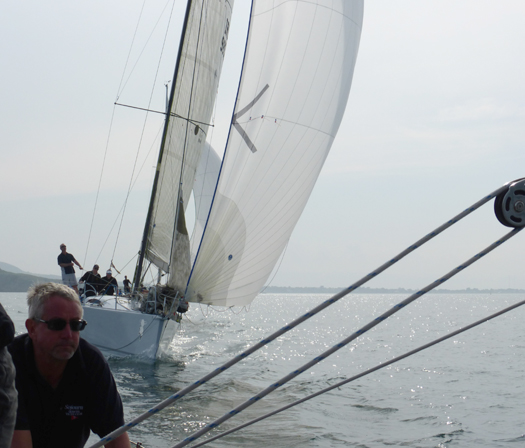
....on the reach Soufriere found her groove and the Horse was soon put astern......Photo: W M Nixon

.....and for as long as we were on the reach, we were lengthening away......Photo: W M Nixon

.....while the crew prepared for the run. Photo: W M Nixon
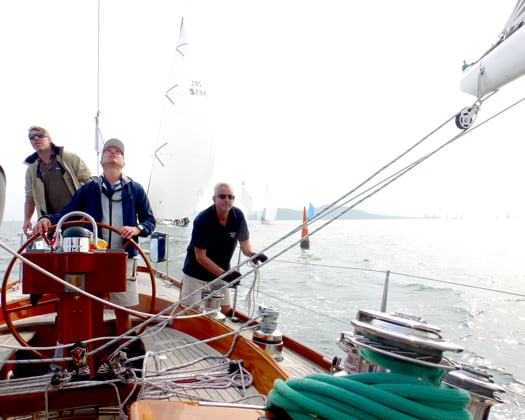
Deflation. We pass the mark at the end of the reach, knowing the run can only mean one thing.......Photo: W M Nixon
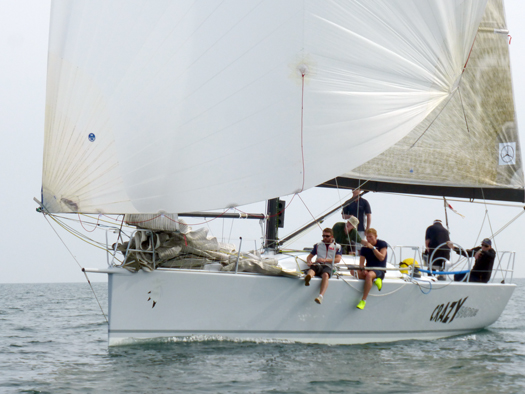
....and with her spinnaker pole deployed, Crazy Horse was soon rolling over us, so we gybed away into what proved to be the light wind side of the leg. Photo: W M Nixon
We rounded the first weather mark vying for the lead on the water with Crazy Horse, and then - mirabile dictu – Soufriere found her mojo and rolled over the Reilly-Chambers boat and led down the short reach to the next turn, but after that it was a wearing dead run with light patches everywhere. Crazy Horse was soon over us again, and as we don't carry a spinnaker pole, we were tacking sharply to lee down the left hand of the run where winds became lighter, while the Horse and Storm went to the right to find a better breeze, and both were ahead at the lee mark.
But then they clearly reckoned they'd used up all the breeze over to the northeast during their success on the run, so for the beat they went to the right where we'd been flat on the run. We meanwhile were left all on our own to do what we wanted, taking a big punt to the left, and it paid in spades. Getting back up to the weather mark, Storm was well astern and we were snapping at Crazy Horse's heels.

On the second long run, we managed to keep in contact with Crazy Horse.....Photo: W M Nixon

.....while Storm took the scenic route, seeking a private breeze in under the cliffs of Ireland's Eye. Photo: W M Nixon
The next run piled on the pain, but somehow we were hanging in with Crazy Horse, and Storm took a flyer right in under the cliffs of Ireland's Eye. With the wind fading, the Committee Boat had gone over towards Malahide to shorten the course at the lee mark, and a fine selection of the 97 boat fleet were running down together towards it from their various courses.
It made for a very civilised finish time instead of hanging around far into the evening, and we might have hoped for a third or even a second as the long lady which is Soufriere had been doing her very best. But then, just as we neared the finish, didn't the breeze pipe up for a crucial quarter of an hour. We finished at a crisp little speed, but down towards Ireland's Eye the two J/109s and the X332 Equinox were coming up towards the finish with bones in their teeth, and a reasonable chance of a third or even a second for us evaporated to fifth, suddenly three minutes down on the fourth-placed J/109 Dear Prudence (Patrick Cruise O'Brien), while the other J/109 Storm had finished at such speed she pipped Crazy Horse for the win.

At last a bite to the breeze, but we're just about to finish.......Photo: W M Nixon
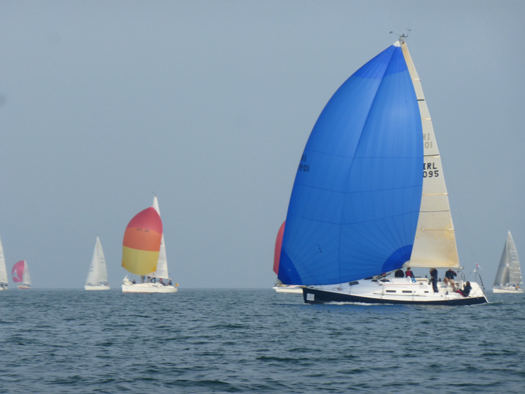
.....so the brief but temporary breeze at the finish brings up the tail-ender Dear Prudence with a bone in her teeth, and Soufriere is pushed back into fifth on CT. Photo: W M Nixon
But that's boat racing. It had been an interesting day in good company, and when she could, the lovely Soufriere rewarded us with competitive performance, at all times with the water tinkling past in that special way it does with a wooden hull. She was a joy to be aboard.
On the 35th Anniversary of the introduction of the Howth Autumn League, it was good to be heading back in the hazy evening sun into this regenerated port where modern facilities are right beside the traditional anchorage. There, the eternally re-born Howth 17s were striking their tops'ls after an afternoon's racing, just as they've always done for 116 years, while continuing with the banter which will go on for ever.
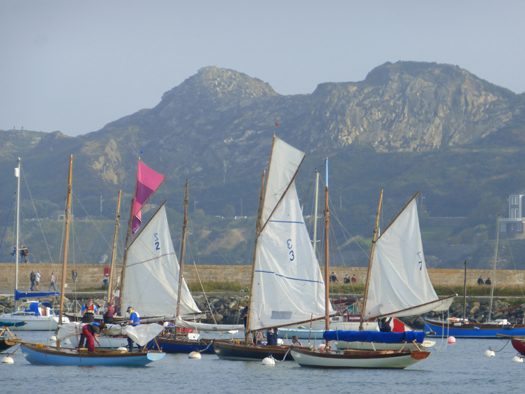
The Howth 17s striking their tops'ls after a Saturday afternoon race, as they have been doing for 116 years. Photo: W M Nixon

A very likeable boat, and remarkably rewarding to race against more modern types. Soufriere in her berth at Howth after the first race of the MSL Autumn League 2014 at Howth, showing the quality of the work Jimmy Foley of Dun Laoghaire puts into her maintenance. Photo: W M Nixon



























